|
This is a collection of Ben's observations about India based on a 9 day visit to Chennai, Hyderabad, Agra, and Delhi (4/20 to 4/29/2011). Ben is a 51 year old white guy from the USA, and this was his first visit to a "developing" country.
He has previously visited Canada, UK, France, Italy, The Netherlands, New Zealand, Portugal, Denmark, and Japan.
-
Master/Slave culture -- weak listening skills:
I have always found when talking on the phone with an (outsourced) customer service agent in India
that they just want to follow a script, whereas I want to explain my problem and have an interactive discussion.
In India I observed that Indians are used to taking orders, not having a give-and-take conversation.
A lot of "Sir" and "Boss".
India's "bargaining culture" is confrontational, not questioning and exploring.
Each side states his position -- everything is assertions.
The narrative is master/slave, not peer exploration.
I explored this topic with my friends Prashant and Raj -- both of whom were born in India but had lived in the USA for years.
And when I got back to the USA I discussed this with my friend Vivek who grew up in Chennai and my friend Salil who grew up in Kanpur.
My Indian friends all agreed that this "master/slave" mindset is pervasive in Indian culture,
and the consensus seemed to be that this was a result of the caste system coupled with
British colonial rule and the very rote nature of education in India.
-
Race and caste prejudices:
In the media -- billboards, newspapers, magazines, video -- the models, actors, etc. all very light-skinned.
They are dressed in "western" clothing, the men are often baring their chests, and the women are wearing clothing that accentuates their cleavage and their legs.
Aside for the enthusiasm for various styles of facial hair on the men, these looks could be found in Los Angeles, New York, London, Paris, Rome, etc.
This focus on being "white" mirrors my experience growing up in Seattle in schools whose studentns were predominantly African Americans:
drug stores and beauty parlors in the Central District stocked skin lightening creams and hair straighteners to make you look more "white".
Similar "beauty" products where very prominent in the Indian stores.
I've read about this preference for "whiteness" in other Asian countries and in Africa.
I found it all rather unfortunate.
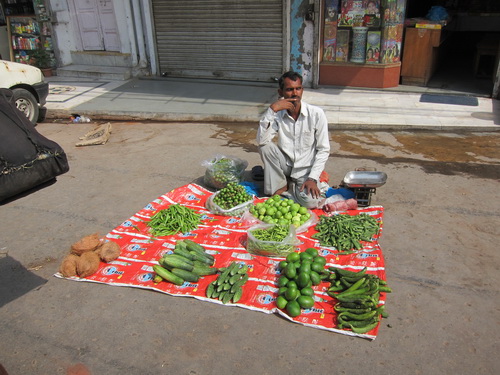
-
Thriving markets and entrepeneurial zeal:
Commerce is everywhere and in your face: billboards of all shapes and sizes, commercial messages painted on the walls
of buildings and brick and stone fences, men carrying plates of coconut slices and watermelon slices and selling them
to people in cars, people with grain stands on the sidewalks, people with tarps on the street filled with produce,
fresh coconut street vendors, sugar cane juicing machines on the street, open air food stalls and shops of all
descriptions, auto rickshaw drivers, bicycle rickshaw drivers, tour guides and people selling trinkets,
post cards, carvings, and chess sets at tourist destinations, makeshift barber shops set up on the wall next to
a street, a bicycle repairman with his tools spread out on the sidewalk with a line of bicycle rickshaws
awaiting service, lines of motorcycles, auto rickshaws, cars, and trucks at the gasoline filling station,
newspapers spread out on a piece of cloth on the sidewalk.
-
Colorful clothes:
Especially in the more southerly cities of Chennai and Hyderabad, women and girls were almost always wearing
very colorful saris of every shade and pattern. Some saris were very simple, while others were quite fanciful
collections of different colors and patterns.
The men general wore no bright colors, and almost all men wore long pants.
School children wore uniforms -- skirts and blouses or saris for the girls,
shorts or long pants and shirts with ties for the boys.
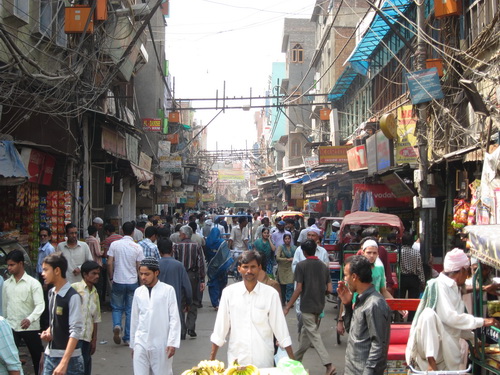
-
People everywhere:
People hanging out of rickshaws, trucks, buses, in the cargo area of trucks. Four people on a motorcycle. Few motorcycle helmets outside of Delhi. No bicycle helmets. Passenger trains with no doors. Women holding infants in their arms sitting on the backs of motorcycles.
No concept of "personal space" -- people crowd around and bump into you, especially when waiting in a queue (which is almost never a straight line but rather a mass of people crowding toward the objective).
Many kids have never/rarely seen a white person, so they tend to be curious, many teens or young adults will say "Hi" as if to practice their English, but tend to be taken aback if when I actually respond.
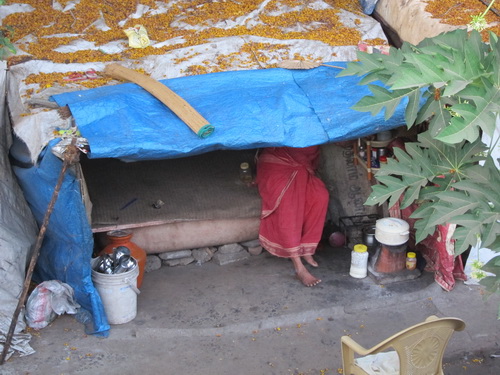
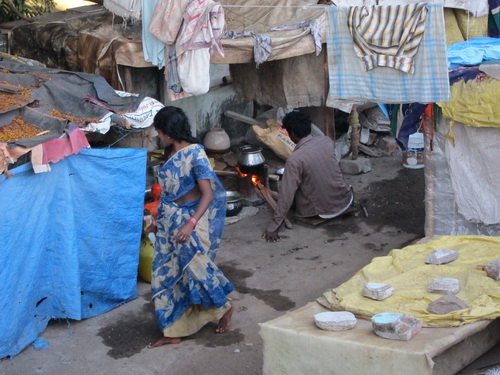
-
Permanent temporary shelters:
In any unused space -- in a field, next to a road, under a bridge, in a trash dump -- you find people living in shelters constructed out of blue tarps, corrugated metal, bricks, etc.
Many had the appearance of having been in use for many years, and many were clearly occupied by families with children.
-
We have very few truly "poor" people in the USA:
Our "poor" people are overweight (too many calories), have plenty of clothes and shoes, live in apartments/homes, have sanitary running water, sewer service, reliable electrical power, landline and/or cellular phones, TVs and cable TV service, and often automobiles.
Poor people in India are typically malnourished and have none of the above.
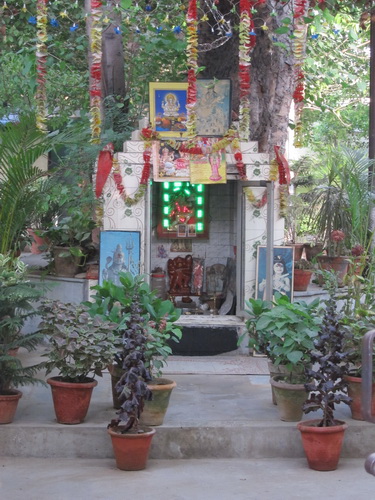
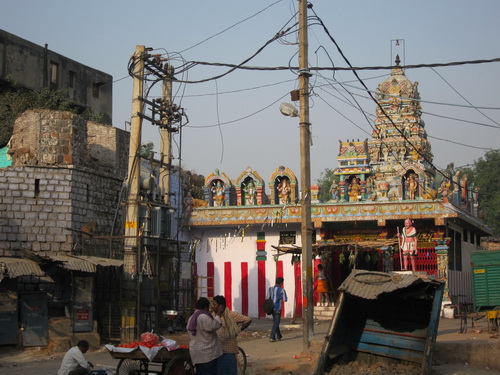
-
Religion more tangible:
Aside from the presence of mosques and temples -- which I also saw in Japan last year -- the people physically demonstrate their piousness with ash and red dabs on their faces, muslim women are dressed in black head-to-toe burquas, there are posters, and there was extensive news coverage of an ailing religious figure.
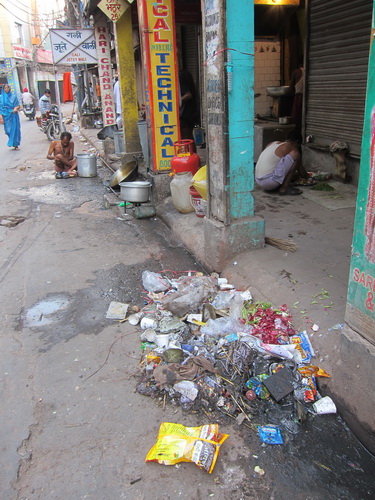
-
Unclean:
Everywhere you look there are piles of dirt, rubble, and trash.
Indians do not seem to believe in public sanitation.
On one morning walk in Delhi I encountered several burning piles of rubbish -- someone had just raked a mound together and ignited it.
-
Food safety:
The water and food safety standards that we are used to in the USA don't exist in India. Or if they do, they are not widely followed. Our pampered Western bodies are not used to the onslaught of microbes prevalent in India. So the common advice is to only drink bottled water (and to make sure that the seal hasn't been tampered with) and to avoid fresh fruits and vegetables (since they may be contaminated with microbes).
-
Air quality:
I had been warned about bad air quality, but except for landing in haze at Delhi on a Monday morning, I didn't have any problems. On the landing approach to Delhi, I could actually smell something different in the air, and the haze was very pronounced as we waited for a gate to open up.
The auto rickshaws have no tailpipe pollution controls (2 stroke motors?) in Chennai or Hyderabad,
but most are CNG (compressed natural gas) in Delhi (so no visible emissions).
There were many modern autos and motorcycles, but also a lot of old tractors, trucks, buses, and auto rickshaws.
-
Public waste elimination:
Friends warned me that I would see people urinating and defecating everywhere, but I only saw public urination once (in Chennai). Aside from the open air urinals, western toilets and toilet paper were very common. I saw more squat toilets in Japan a year ago -- but then I was visiting more rural parts of Japan.
-
Street vendors selling all manner of goods and services:
Fresh coconuts, watermelons, sugar cane juice, all manner of fruits, vegetables, and grains, scrapped front automobile bumpers, street-side barbers, bicycle repair services, sawing plywood, etc.
The larger open-air food stalls/stores sell fruits, vegetables, eggs (stacked by the 144), skinned whole animals, live chickens, etc.
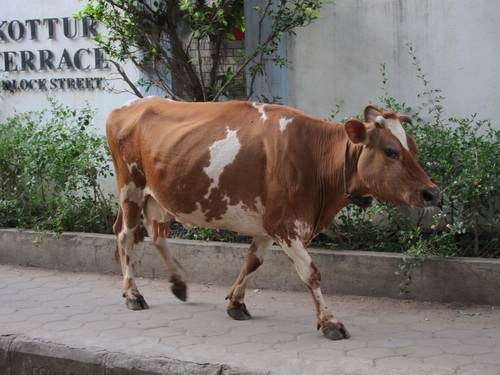
-
Animals running loose:
Dogs, cows, water buffalos, goats, and even a monkey!
-
Road travel is a big game of "chicken":
There are few traffic lights, and they are modestly respected.
But there is almost no "lane discipline" -- pedestrians, hand carts, bicycles, tricycle rickshaws, auto rickshaws, scooters, motorcycles, farm tractors, cars of all sizes, trucks of all sizes, and buses share the roads with dogs and cows and horse-drawn and camel-drawn carts.
Vehicles nominally drive on the left as in other former British colonies, but passing is constant and varied.
Any vehicle with a horn is using that constantly to alert animals and people in front of them.
In Chennai and Hyderabad this was primarily a courtesy, whereas in Delhi the honking seemed to have more of an edge of frustration impatience to it (as in New York City).
Despite all the all the chaos, the traffic moves like a fluid ballet and I only saw one accident during my nine days.
-
Advertising is rampant:
Billboards, banners, painted buildings, painted walls, and flyers are everywhere.
No apparent restrictions on billboards, flags, signs, etc -- Pepsi and Coke both give away (I assume) a lot of signage for small roadside shops. Farmers and property holders get their brick fences and walls painted for free by mobile telecom companies and others companies who want to advertise.
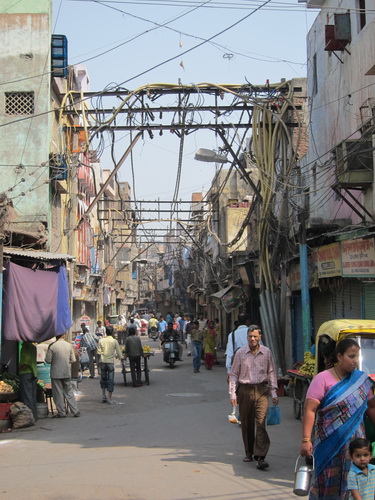
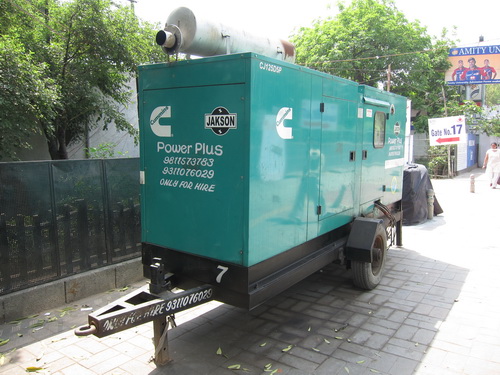
-
Unreliable electrical power:
Shops and fancy hotels did not have reliable power.
In one shop they couldn't take a Visa card for payment as their power was out and it wasn't scheduled to return for several hours. Or maybe the clerk didn't want to pay the Visa transaction fee? At the Ista Hotel Hyderabad it went off 3-4 times in the space of half an hour at ~4:00 p.m. on Sunday 4/24.
-
Infrastructure:
India needs to invest in freeways, reliable electricity, and clean water. The existing flexible transport methods -- walking, bicycle (cart), tractor, auto rickshaw, car, bus, truck -- can take advantage of new and better roads quickly.
Mass transit is I expect too expensive/inflexible.
-
Cold (supply) chain:
I've read that India has a very weak supply chain to transport and deliver products that are cold -- fresh milk, fruits and vegetables, meats, etc. That was certainly my experience -- I saw groceries sitting out on the sidewalk and in open-air store fronts that was not refrigerated in +90F weather. And the 2010 Sula Vineyards Merlot from India that I had one night tasted "cooked" -- it had clearly been put through some very high temperatures on its way between the winery and the table (and this was at a pretty nice hotel).
-
Many signs of low labor costs:
Individuals sweeping the streets with straw brooms.
Individuals using two pieces of rectangular metal to pick up street refuse and dump it in small wheeled waste carts.
Carts loaded to over-flowing with hay and pushed by people or towed by tractors.
Most signage -- on cars, trucks, brick walls, etc. is hand painted and lettered -- no stick-on letters/numbers as in the USA.
-
Private security guards everywhere:
They are hired to protect protect stores, groups of homes ("enclave" or "colony"), individual homes, etc.
It emphasizes that there is a big divide between the rich (and middle class) and the poor --
much more dramatic than anything I've seen in the USA.
-
Education (advertising) is pervasive:
Primary and secondary schools and colleges of all stripes have buildings spread around the cities and they advertise their services in all sorts of public areas.
-
College buses:
Many colleges have their own buses, prominently labeled. Is that because the public transportation is so inadequate, or do the buses do double duty as rolling advertisements?
-
Construction everywhere in Hyderabad:
Large commercial and residential buildings under construction almost everywhere I went.
Aside from large commercial buildings, most of the construction I saw relied on what appeared to be hand-made bricks.
-
Construction requires a lot of manual labor:
Even in the high-rise buildings I observed, there seemed to a great deal of manual labor.
And certainly in the smaller building construction projects, laborers were carrying bricks by hand and on the tops of their heads.
The bricks themselves looked very hand-made, and (orderly) stacks of bricks and mounds of sand (for mortar I presume) were everywhere.
Construction scaffolding many stories high was most often constructed from lashed together wood (not bamboo) poles.
-
Beggars and touts:
I had been warned that they could be very aggressive, but it wasn't too bad.
I was used to dealing with odd characters growing up in Seattle and taking the city buses to and from school, so I didn't look them in the eye and ignored them.
Any kind of a response, even a head shake "no", seemed to be an encouragement.
There were men selling all manner of things -- especially near the tourist attractions -- and occasionally there was a woman with a small infant motioning with her hand to her mouth "I'm hungry -or- food for my baby".
I saw a few beggars that had a variety of gruesome physical limitations -- a missing limb, or very deformed bodies.
And then there were the tour "guides" at the popular attractions who aggressively struck up conversations.
Ignoring, shaking my head, and saying "no" worked most of the time, but I few times I yelled at an individual angrily, and that did the trick.
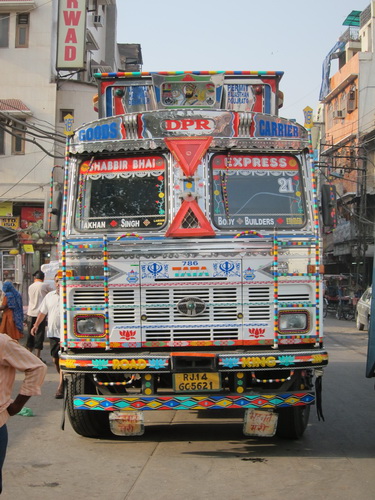
-
Decorated trucks:
A bit like trucks in Mexico (at least judging from photos I've seen), many trucks are decorated quite elaborately,
not just with paint but also with all manner of items hanging off all sorts of different areas of the truck.
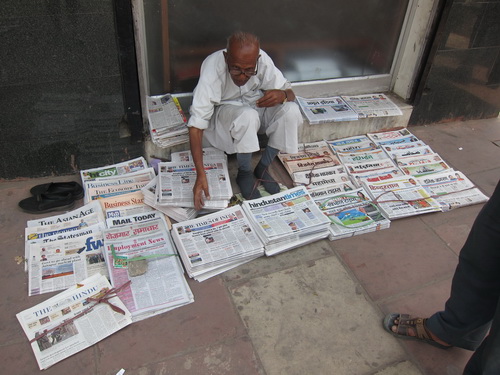
-
Newspapers still popular:
There seemed to be many more newspapers, and the English language papers I read still have classified advertising sections -- due to much lower internet penetration I assume.
-
North to south modernity gradient:
I wonder if southern India is more traditional than northern India?
Most of the women I saw in Chennai where wearing saris.
When I went ~300 miles north to Hyderabad, there were a few more women in western clothing, and there were many more women where head-to-toe black burquas. When I got to Delhi, the majority of men and women seemed to be wearing western clothing.
-
Education:
More than half of the people I asked -- taxi drivers, auto rickshaw drivers, seatmates on airplane flights, waiters in restaurants, tour guides, etc. -- attended private (primary and secondary) schools in India.
On my HYD to DEL flight, my seat mate told me he had paid 1K INR/year for secondary school 14 years ago: he did state curriculum through 10th form (grade), 2 years in "junior" college, 2 years MBA, has been working for 10 years.
School children are all wearing uniforms -- school colors tie, white shirt, dark pants for the boys; all manner of styles for the girls, from a typical plaid skirt and white shirt to more fanciful sari-like creations.
-
Haggling over prices:
Auto rickshaw rides, road-side stands, and many stores do not list prices.
So you have to haggle. And if you're a white guy from the USA, you've got "sucker" written all over you.
-
Powers of 10:
In the West numbers are written down in groups of three, separated by commas or periods depending on what country you're in. In India, they have the "Lakh" (10^5) and and the "Crore" (10^7), and numbers are written with these in mind. So in the USA I would write 1,200,000 and say "1.2 million", but in India that would be 12,00,000 and I would say "12 Lahk". Similarly, 120,000,000 would be 12,00,00,000 and "12 Crore" in India.
-
Alcohol availability and price:
Muslims do not drink alcohol, and Hindus do not seem very keen on alcohol, either.
I saw almost no alcohol advertising, and there was either no alcohol or only a modest selection in most restaurants. In Hyderabad the prices were much higher than Delhi -- friends told me that was intended to discourage alcohol consumption.
-
Security lines everywhere:
As a response to the 2008 terrorist attacks in Mumbai, India now has security personnel and metal detectors at the entrance to malls, museums, hotels, and monuments -- any place where any large number of people might gather. In most cases, the walk-through metal detectors seem inoperative, and the security personnel give everyone a wanding and a pat-down. At least in the USA the TSA pat-down is a rare occurrence.
-
Gents and Ladies:
In airports and at large tourist sites, there are separate security lines for men and women. I assume this is in part out of respect for the privacy of Muslim women -- in many cases there are shrouded pat-down booths for the women.
-
Modern shopping malls:
We visited one shopping mall in Hyderabad and it was very similar to what you might find in the West -- pop music, bright and colorful lighting, central AC, and flashy.
-
Coke in bottles:
I had 7-Up, Pepsi, and mango juice served in aluminum cans just as in the USA.
But Coke was also available in bottles.
I saw small trucks with shelves of crates of empty Coke bottles.
-
Corruption:
I had read about corruption in India and I have discussed it with my Indian friends, but I did not experience any corruption first hand. However, I did see prominently labeled homes of a few government ministers in Delhi, and on the toll road to Agra there was a big sign listing the titles of all the elected officials and bureaucrats that did not have to pay the road toll.
I also read an article while on my trip that claimed that only 15% of US$9 billion spent on a rural job creation program (building infrastructure) last year had reached the intended recipients (the rural poor). The rest had been siphoned off along the way by corrupt politicians and bureaucrats. And the funds were not allowed to be used for machinery, so as to increase the number of jobs created. The article pointed out that the poor did not learn any new skills as a result.
|
| | |
Last updated Saturday, May 7th, 2011.
© 1997-2026 slivka.com. All rights reserved.
|